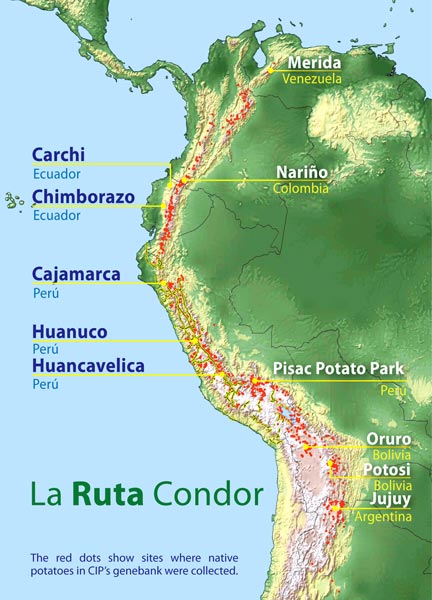The route of the condor is apt inspiration for CIP’s ongoing project restoring and conserving the genetic diversity of native potatoes in situ – high in the Andes, where the crops originated.
“The condor is an ancient deity, a potent image; and the ‘Ruta Condor’ concept springs from this vision”, says René Gomez, agronomist and CIP’s genebank curator for native potatoes. “It’s like looking through the eyes of the Condor, watching over the farmers in their fields managing the richness of their resources, and rescuing their culture and ancient wisdom”.
The Qhapaqñan: Back to Where it all Began
CIP’s program of returning virus-free planting material to farmers started a decade ago in just four Andean communities with the aim of restoring the tremendous genetic diversity that once existed in the original birthplace of the potato. Since then scientists, farmers, and local partners have repatriated over 4,600 samples of more than 1,200 varieties of native potato in 41 locations, following the ancient north south pre-Columbian route which unified the Inca Empire.
An International Network of Conservation Micro Centers
CIP scientists chart potato biodiversity using this original route as a guide to locating a chain of micro-conservation sites that will eventually span the Andes from Mérida in Venezuela to Jujuy in Argentina.
The Pilot Project: Pisac Potato Park
“When we map native potato diversity, we see that the greatest concentration is in Paucartambo, in Cusco, so that’s where we chose to locate the Potato Park,” says Gomez. In conjunction with the Association for Nature and Sustainable Development (ANDES), CIP helps support the cultivation of more than 600 varieties by over 1,200 families among the six communities that make up the Park. More than 400 regional native potato varieties have been returned successfully to the area.
Improving Livelihoods
The goal is that other centers will adopt their own versions of the Potato Park model with a focus on developing the market chains linking enhanced production to consumption. “The idea is not only conservation but to develop a sustainable management which can offer some benefit to the communities,” explains Gomez. In 2007, The San José de Aymara communal seedbank in Huancevilica won the BBC Global Challenge Award with its participation in the Tikapapa project commercializing native potato. Eco tourism is also beginning to reap benefits in Pisac, where visitors can taste the potatoes they see being cultivated.
Dynamic Conservation: A Frontline Defense Against Global Climate Change
Gomez believes the project illustrates the dynamic, complementary relationship between in situ and ex situ (where material is stored in CIP’s laboratory genebank) conservation. “In a natural environment the ‘struggle’ between the genes and the natural stresses they encounter ensures that evolution continues. However, though nature is dynamic, it is also slow. Using ex situ preservation, we have the tools to accelerate this kind of natural selection process.”
The project represents a prime opportunity for a cooperative international effort to manage nature’s resources. With the involvement from public and private partners, along with funding, there is potential for the concept to be applied to other Andean crops, forming part of an integrated approach to the conservation of biodiversity.

